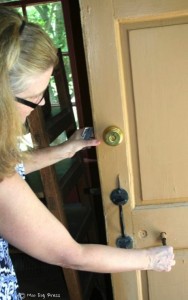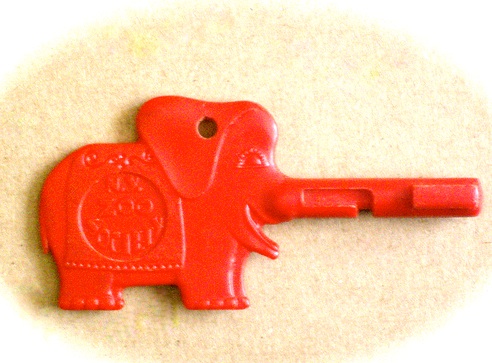Technology & Ahead Of Time Found Curiosities: ‘Trunkey’ The Elephant
“When you want to teach children to think, you begin by treating them seriously when they are little, giving them responsibilities, talking to them candidly, providing privacy and solitude for them, and making them readers and thinkers of significant thoughts from the beginning. That’s if you want to teach them to think.”
– Bertrand Russell
Editor's note: On the road means finding ideas as business and life intertwine. While a “sleeper” of a story that combines innovation and old-fashioned service delivery is being developed, let's revisit some curiosities and ideas ahead of their time.
Objects can unlock knowledge if questions are asked and real curiosity is the fuel behind the queries.
Collectors and hunters of things have been around since the dawn of time. It's a very human trait, ingrained in some stronger than others, that is all about observation, patterns, and noticing connections. Since most people no longer need to hunt down the energy contained in foods to survive, that energy is channeled in other ways that are not so productive, such as endless shopping.
For anyone who has lived in an old house and unearthed original hardware and doors stowed in the attic under eaves when previous dwellers modernized the structure, there is true history to be found. Someone had to valued and preserved the first drafts of history – letters, old diaries, newspapers, written records of news and manuscripts that would otherwise have been lost. Spend an time at a local historical society or a library's history room and you will see layers of stories and facts kept safe, waiting for someone to stitch bits together and make them sing.
Some objects from childhood take on a mythlike quality, dimly remembered until one is seen, sparking a memory that is almost visceral. A red elephant-shaped key from a long ago Bronx Zoo visit is one such item.
My mother was a magpie of sorts, a keeper of natural wonders and fabled items (or so it seemed). There was a thrill as a child when the jar was opened and a jumble of treasures spilled out as she sought her quarry – a practical object such as a starter for the lights over the sink. A red plastic elephant – stylized and flattened – always stood out. Turns out, there is a story of ingenuity that goes with it.
The “Trunkey” was invented by Bruce Sedley of California and the Children's Fairyland in Oakland was where they first went into use, according to an informative site called Bay Area Radio Museum, which devotes a page full of accomplishments to Sedley. An image of another type of key that is used for audio presentations is also featured.
Here is an excerpt:
The genius behind the project was William Penn Mott, the director of the Oakland Park Department, who a few years later would become the Director of the National Parks of the United States. To get the children's interest he had installed record playing machines operated by five-cent coins at the sets to play musical nursery rhymes, but the units were always breaking down.
As I was familiar with tape playback message repeaters, I was called in and suggested that they use them and that instead of a coin, sell the children a lifetime “Magic Key to Fairyland,” a gold-plated ornamental plastic key that could be inserted into a keyhole in post-mounted “Talking Storybooks” at each set. Bill Mott accepted the proposal, a contract was signed, and the Park Department made and installed the first “Talking Storybooks” in the fall of 1958.
…
Armed with the sales figures (and the promotional opportunity of free TV time), the “Friends of the Zoo” eagerly agreed to my contract to install the system throughout the Zoo absolutely free, on the same conditions as at Fairyland. I would make them a new key however, an elephant-shaped key with the trunk straight out which became the part to insert into the Talking Storybook keyhole. So “Trunkey the Elephant” was born, and in 1959 the 41 Storybooks in the Zoo were operational.So many keys were now required that I hired local housewives to assemble the colorful tags on the keys and either box them for Fairyland or put them on large peg boards by the hundreds for the Zoo.
The idea caught on and these devices were then adapted for use by zoos across the country. The key was made in different colors and are now very collectible. A cursory search on eBay resulted in variations in condition and descriptions. Pristine ones fetch $40 and up, but I don't recall a paper tag attached to the key from my own childhood.
There is even a supposedly complete set on Flickr – a rainbow collection of all Trunkeys. See, this could go on and on – and all from one small plastic bit of functional whimsey stored away from a family trip.
The closest to the actual clown jar that could be found is a listing for a “Vintage Happy Clown Hands Up Cookie Jar Canister Marked California Originals” – that listing is linked to the image.
On Pinterest a search for vintage cookie jars turns up more possibilities than you can shake a stick at – if a happy clown with its hands in the air doesn't stir up memories for you, maybe a Little Red Riding Hood, Gumby and Pokey, a Dutch boy, or Pinocchio will. There are also multitudes of cows, cats, squirrels, elephants, and other designs that can captivate an onlooker for hours. For a deep dive into odd objects, found items in a jumble, search eBay listings such as this one.

“Look closely. The beautiful may be small.”
– Immanuel Kant
“The place through which he made his way at leisure was one of those receptacles for old and curious things which seem to crouch in odd corners of this town and to hide their musty treasures from the public eye in jealousy and distrust. There were suits of mail standing like ghosts in armour here and there, fantastic carvings brought from monkish cloisters, rusty weapons of various kinds, distorted figures in china and wood and iron and ivory: tapestry and strange furniture that might have been designed in dreams. The haggard aspect of the little old man was wonderfully suited to the place; he might have groped among old churches and tombs and deserted houses and gathered all the spoils with his own hands. There was nothing in the whole collection but was in keeping with himself nothing that looked older or more worn than he.
“As he turned the key in the lock, he surveyed me with some astonishment which was not diminished when he looked from me to my companion. The door being opened, the child addressed him as grandfather . . .”
– The Old Curiosity Shop by Charles Dickens
Editor's note: As travels take us near and far, we will feature the stories of what is found along the way. Stubby the dog is one of our all-time favorites – seeing the new beautiful bronze statue of him “saluting” recently placed at Vets Park in Middletown will be featured, along with a video of those present at the unveiling.





